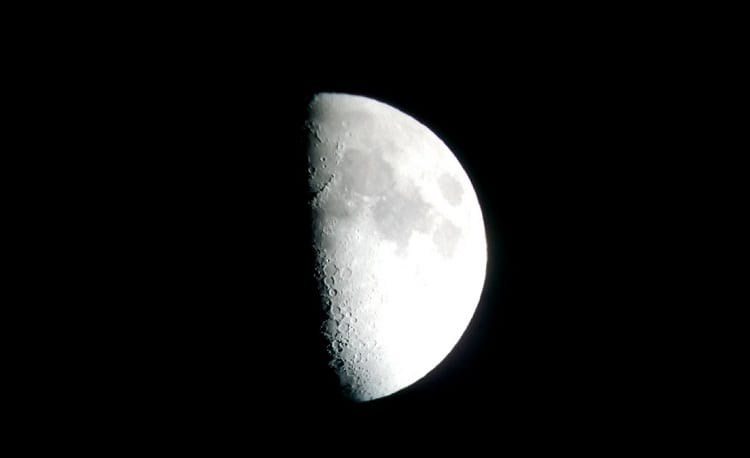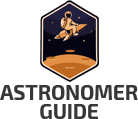Are you sick and tired of taking pictures of the moon with your cell phone and being left bitterly disappointed because you can’t see any details?
It’s time to learn the right way to capture the moon – and you might have to leave your cell phone at home.
Why can’t your cell phone take quality pictures of the moon?
There are many problems with your cell phone camera, such as that its lens is too wide and its sensor creates a lot of digital noise.
That doesn’t mean you can’t use your phone, but you’ll have to use it with other equipment. With that in mind, here’s what you need to know about shooting the moon. Let’s start by checking out the gear you need to ensure you have for moon shooting success.
Contents
Important Gear You’ll Need For Shooting The Moon

If you want to take pictures of the moon along with other objects, then you probably won’t need special equipment. If you want close-ups of the moon, however, such as because you want to see it in greater detail, you’ll need to get the right gear. Here’s what you’ll need.
Tripod
You need to avoid that dreaded camera shake when taking images of the moon, so you’ll need to invest in a stable tripod. This is especially important if you’re using a telephoto lens (more on that in a bit) because these lenses tend to wobble around a lot.
What if you’re using a telescope?
Then you should invest in a mount for it. This is an important item that will track how the moon moves across the sky, therefore helping you to take better pictures of it. You can find motorized or manual mounts.
Camera
The good news is that you can use any camera to take pictures of the moon, but for high-quality pictures you’ll need to ensure that you have a DSLR camera with a long lens or a bridge camera. Let’s look at what these are.
- DSLR: this type of camera is useful because you’ll have total control over the camera and lens settings. Canon makes the most popular DSLR cameras that are used for astrophotography.
- Bridge: this is also known as a “point and shoot” camera. It’s budgpet-friendly so it’s great for beginners, but it also works really well when you pair it with a reflector telescope.
Long Telephoto Lens
While it’s fine to use the lens kit that came with your camera when you purchased it, it’s not going to have that magnifying feature you need if you want to capture details on the moon. That’s why you need a telephoto lens.
Make sure you check the lens’s focal length, which is measured in millimeters. You want one that’s got a high focal length as the higher it is, the more you’ll be able to zoom into the moon!
If you really want to go pro with your images, you’ll need to get your hands on a telephoto lens that has a focal length of between 400mm and 800mm, but these can cost thousands of dollars.
If you don’t want a telephoto lens that will blow your budget, you can make use of a budget-friendly teleconverter. This works by being combined with your camera and lens so that it can increase the focal length.
Shutter Release
When you use a long telephoto lens to take pictures of the moon, any slight vibration can cause the image to lose its sharpness, which is why you should make use of a remote shutter release.
Shutter Speed
The shutter speed is important to keep your images clear. If you choose a slow shutter speed, this will result in blurry images. You want to ensure you have shutter speed that’s at a 1/125-second minimum, as BH Photo Video reports.
Moon Filters: Why You Need Them
Moon filters can make a big difference in how well you photograph the moon. These reduce the amount of glare in your image while also boost contrast so that you can better see all the details of the moon’s surface.
A cool way of describing a moon filter is to say that it’s a pair of sunglasses for your telescope, as Telescopes Plus reports. How it works is that it threads into the bottom of the telescope’s eyepiece.
Other Tips For Shooting The Moon
It’s not just your camera and lens that influence the quality of your moon pictures. There are other things you need to consider when you want to get a professional-looking picture.
- Make sure you have a clear view of the moon. It’s always a good idea to check out the sky the night before you take pictures, and make use of a moon-tracking app such as Sun Surveyor, as this will help you see how the moon will look on any given night.
- Don’t always choose the moon as your only subject. Sometimes it’s better to choose to shoot other objects with the moon as this will provide perspective. For example, the sight of the full moon above a beautiful tree might be more interesting than the full moon against a dark sky.
- Consider shooting the moon before it gets dark. Although you might think this won’t work, a good tip to follow if you’re just starting out with taking pictures of the moon is to shoot it during daylight. This is because the light will mean that the moon is more visible.
- Avoid taking pictures of the full moon. Not only have full-moon pics been done to death, but since the whole moon is lit up when it’s full it’s easy to get a low-contrast image. This means you won’t be able to properly see or capture the texture of craters and the moon’s shadows as you would when the moon is in a different phase.
How To Consider Composition In Your Moon Pics

If you want to take pictures of the moon with an interesting object or scene, such as a mountain or tree, you will need to consider the composition of the image.
If you’re using a wide-angle lens, the moon will only occupy a small space in the image. On the other hand, if you’re using a telephoto lens, the moon will take center stage.
When it comes to your camera settings, you should use these to adjust the composition of your moon pictures. You want to use the grid on your camera (note: every camera will have a grid so check out its manual to find it).
This will enable you to place the moon wherever the lines meet so that your shot will be balanced. Use what’s known as the “Rule Of Thirds” to help you.
The “Rule Of Thirds” basically means that you imagine breaking the image down into thirds so you end up with nine parts that are in a grid.
The grid has four lines (two vertical and two horizontal) that help you to figure out where to place all the photo elements. If you put the elements in intersections on the grid or along its lines, your photo will be more balanced, as Digital Photography School reports.
Can You Take Pictures Of The Moon With Your Phone?

While it is possible to take moon pictures with your phone, you will need some important gear.
A telescope
This will be your telephoto lens and it should offer a minimum of 25x magnification as well as an aperture of over 70mm so that it will collect enough light.
Phone adapter
Some telescopes you purchase come with a phone adapter included, which is a nice touch. You’ll need a telescope phone adapter so you can attach your phone to the telescope’s eyepiece.
Phone app
You’ll need to tweak your phone settings to get a great shot, such as by making use of fast shutter speed, so make sure you have installed an app such as ProCam on your phone.
Related Questions
What app will help you track the moon?
Deluxe Moon is an app that tracks the moon and determines the level of light that the moon will reflect in the sky. It also has other features, like a moon phase calendar, and it’s compatible with iPhone and Android phones.
What telescope magnification is best for viewing the moon?
The good thing about the moon is that it will look good with more magnification, unlike some other celestial objects, so you can reach high magnifications of 150x or higher to see its details.
Conclusion
Although it’s a celestial object that’s one of the easiest to see, it’s certainly not always easy to photograph! However, after reading this guide, you hopefully have a better strategy for taking quality pictures of the moon without the added stress.

